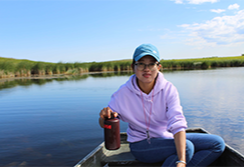Understanding the impacts of hydrology on seasonal and spatial water chemistry changes in two adjacent prairie potholes in North Dakota using stable isotopes

Kui Hu is a Ph.D. student in the Environmental Sciences and Conservation Program and Department of Biological Sciences at North Dakota State University (NDSU). She holds a Bachelor’s Degree of Science in Geography and a Master’s Degree in Physical Geography from Yunnan Normal University, China. She is currently working with Dr. Jon Sweetman on detecting the freshwater community changes and ecosystem resilience in response to climatic change (especially extreme drought events) through applying limnological and paleolimnological methods (i.e. diatoms, cladoceran, isotopes and geochemical proxies).
Understanding the impacts of hydrology on seasonal and spatial water chemistry changes in two adjacent prairie potholes in North Dakota using stable isotopes
Prairie-pothole wetlands are an important freshwater resource in the Northern Great Plains and play a significant role in providing vital ecosystem services. However, the high variability of regional climate and complex hydrology can make it difficult to effectively manage these systems. Understanding how hydrology affects the water-balance and variability in water chemistry in these wetlands is important for understanding how future changes in climate and land-use might affect these ecosystems. To add to our understanding of the hydrologic influences on water chemistry of prairie-pothole wetlands, we examined the water chemistry of two adjacent, but hydrologically contrasting prairie-pothole wetlands in the Cottonwood Lake Study Area, North Dakota.
Project Objectives:
Our goals were to:
1. To identify the isotopic composition of water inputs to these wetlands in two different weather condition and the main influence factors
2. To investigate the water chemistry changes patterns of these hydrologically different wetlands
3. To determine the drivers of water chemistry of these two wetlands.
Progress:
We found the closed-basin wetland to be more susceptible to precipitation-driven variability in water levels compared to our other study wetland, which had a natural outlet that limited maximum water depths during periods of high precipitation. Our results also showed a depleted input-water isotopic signal in both study wetlands during the wetter year that likely resulted from increased snow melt or direct precipitation inputs. Nutrient concentrations in both wetlands responded mostly to precipitation amounts, while major ions concentrations were more closely related to topographic influences on hydrology; the closed-basin wetland possessed higher concentrations of major ions compare to the open-basin wetland. These differences were likely due to an increased pond periphery in the closed-basin wetland that provided more ionic movement from shallow groundwater into the wetland and losses of ions through the outlet of the open-basin wetland during the wet period. Our results highlight the importance of considering basin topographic features such as natural or artificial outlets when managing prairie-pothole wetlands.
Significance:
Combing water dual isotope and water chemistry, annual input water isotopic signals were identified in two hydrological different wetlands in Prairie Pothole Region. This study showed annual variability in both climate and local landscape differences resulted in differences in wetland hydrology and water chemistry. This research provide an invaluable approach for both hydrological and water quality management. Additions, this study highlights the importance of considering basin topographic features such as natural or artificial outlets when managing prairie-pothole wetlands under climate change.
Conference/Seminar Presentations:
Hu, K., D. M. Mushet, and J. N. Sweetman. 2021. Understanding the impacts of hydrology on seasonal and spatial water chemistry changes in two adjacent prairie potholes in North Dakota using stable isotopes. PALS meeting, May 4-5.
Hu, K., D. M. Mushet, and J. N. Sweetman. 2021. Using stable isotopes to better understand hydrological impacts on water chemistry in prairie-pothole wetlands of the Northern Great Plains, USA. Great Plains Limnology Conference, October 23, 2021 virtual.

Jon Sweetman
Biological Sciences
Office: Stevens 211A
Telephone: 701-231-8991
Email: jon.sweetman@ndsu.edu


